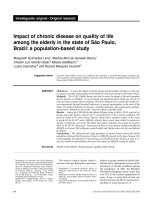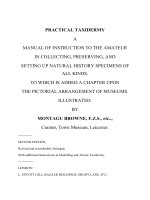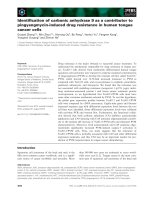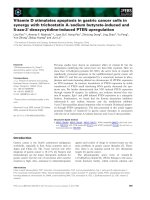Knockdown of TIPE2 increases the proliferation in lipopolysaccharidestimulated gastric cancer cells
Bạn đang xem bản rút gọn của tài liệu. Xem và tải ngay bản đầy đủ của tài liệu tại đây (4.7 MB, 8 trang )
Liu et al. BMC Cancer (2018) 18:857
/>
RESEARCH ARTICLE
Open Access
Knockdown of TIPE2 increases the
proliferation in lipopolysaccharidestimulated gastric cancer cells
Wenming Liu1†, Yanyun Fan1†, Ying Shi2,3†, Zhenhe Lin1, Xiaoxiao Huang1, Wei Huang2,3, Dongyan Shen5*
and Zhongquan Qi4*
Abstract
Background: Gastric cancer (GC) is one of the most common malignant diseases with high morbidity and
mortality, especially in Asian countries. During the GC developing progress, TIPE2, a member of TNF-alpha induced
protein 8-like (TNFAIP8L) family, may play important roles. However, the molecular mechanisms of TIPE2 contributing
to cell proliferation and tumor growth are poorly understood in GC. We performed flow cytometry to detect the cell
cycle of TIPE2-knockdown GC cells under lipopolysaccharide (LPS) stimulation.
Methods: We measured TIPE2 expression in tumor samples from 46 human GC patients at mRNA level by Realtime
PCR and in 68 pairs of GC tissues at protein level by immunohistochemistry. We established stable TIPE2 knockdown
SGC7901 and BGC823 cell lines and performed CCK-8 and EdU proliferation assays under the stimulation of LPS. And
then we analyzed AKT, IκBα and ERK phosphorylation levels, as well as cycle related proteins CDK4 and CyclinD3 in the
stable TIPE2 knockdown SGC7901 and BGC823 cells.
Results: Our present studies indicated that the expression of TIPE2 was significantly decreased in tumor tissues
compared to distant mucosa tissues in human GC patients. TIPE2 inhibited proliferation stimulated by LPS in SGC7901
and BGC823 cells. Silencing of TIPE2 significantly decreased cell G0/G1 phase ratio and increased G2/M phase. TIPE2
knockdown SGC7901 and BGC823 cells declined AKT and IκBα phosphorylation. TIPE2’s action on GC cell cycle was.
Conclusions: Our results demonstrated that TIPE2 is a novel tumor suppressor gene that inhibits GC growth may
mediated via AKT and IκBα phosphorylated activation. We revealed that TIPE2 may effectively interdict neoplasm
development, which has potential clinical application values for GC targeted therapies.
Keywords: TIPE2, Gastric cancer, AKT, IκBα, Cell cycle, LPS
Background
Gastric cancer (GC) is one of the most common malignant diseases with high morbidity and mortality in
digestive system [1, 2]. In China, new cases of GC
accounted for 40% of the world incidence each year,
which were ranked the second morbidity and the third
mortality of the malignant tumors [3]. Currently, due to
lack of specific and effective screening indicators, most
* Correspondence: ;
†
Wenming Liu, Yanyun Fan and Ying Shi contributed equally to this work.
5
Biobank, The First Affiliated Hospital of Xiamen University, Xiamen 361003,
Fujian Province, China
4
Organ Transplantation Institute, Medical College of Xiamen University,
Xiamen 361005, Fujian Province, China
Full list of author information is available at the end of the article
patients have entered the advanced stage with poor
treatment and poor prognosis [4].
TNFAIP8 expression in GC is correlated with tumor
development and immune homeostasis [5]. TNFAIP8L1
enhances the apoptosis and plays an essential role in
inflammatory associated tumorigenesis [6]. TNFAIP8L3
is an oncogene to promote carcinogenesis, highly expressing in human digestive tumor, such as colon and esophageal cancer [7, 8]. TIPE2, also known as TNFAIP8L2,
negatively regulates both innate and adaptive immunity
and decreases human hepatic cancer [6]. Deficiency of
TIPE2 expression has also been found in non-small cell
lung cancer (NSCLC) and renal cell carcinoma, which is
associated with tumor metastasis and TNM staging [9, 10].
© The Author(s). 2018 Open Access This article is distributed under the terms of the Creative Commons Attribution 4.0
International License ( which permits unrestricted use, distribution, and
reproduction in any medium, provided you give appropriate credit to the original author(s) and the source, provide a link to
the Creative Commons license, and indicate if changes were made. The Creative Commons Public Domain Dedication waiver
( applies to the data made available in this article, unless otherwise stated.
Liu et al. BMC Cancer (2018) 18:857
However, the molecular mechanisms of TIPE2 underlying
GC initiation and development are still not explicit.
In our current study, we demonstrated that TIPE2
expression was down-regulated in GC progression. The
effects and mechanism of TIPE2 in LPS-mediated proliferation and GC growth would be further discussed.
Methods
Ethics statement
This study was approved by the Ethics Committee of
Zhongshan Hospital, Xiamen University (Xiamen, Fujian
Province, China). Written consent was obtained from all
the participants.
Page 2 of 8
with rabbit anti-human TIPE2 antibody (15940–1-AP,
Proteintech, Wuhan, Hubei, China) overnight at 4 °C.
Next day, the sections were rinsed with PBS, incubated
with biotin-labeled secondary antibody for 20 min at room
temperature, rinsed againwith PBS, and incubatedwith
horseradish peroxidase polymer conjugate (Elivision™
Super HRP (Mouse/Rabbit) IHC Kit-9922; Maixin Biotech,
Fuzhou, China). The sections were stained with the
chromogen 3,3-diaminobenzidine from the DAB Detection
Kit (DAB-0031; Maixin Biotech, Fuzhou, China) for
approximately 3 min and counterstained with hematoxylin.
CCK-8 cell proliferation assay
Cell culture
The SGC7901 (TCHu 46) and BGC823 (TCHu 11) cells
(purchased from Cell Bank, Shanghai Institutes for Biological Sciences, Shanghai, China) were cultured in RPMI
1640, with 10% fetal bovine serum (Life Technologies,
Grand Island, NY, USA) and 1% penicillin G/streptomycin
at 37 °C in an atmosphere of 95% air and 5% CO2.
Establishment of stable TIPE2 knockdown cells
shRNA sequence 213 (5’-GATCCACCTGATCAAAGTG
GCCATTTCAAGGAGAATGGCCACTTGATCAGGTTT
TTTTACGCGTG-3′), sequence 431 (5′- GATCCGCAA
GATCTGTGACGGACTTTCAAGAGAAGTCCGTCACA
GATCTTGCTTTTTTTACGCGTG-3′), and sequence 523
(5′- GATCCGCATGACGGCACTTAGCTTTTCAAGAG
AAAGCTAAGTGCCGTCATGGTTTTTTTACGCGT
G -3′) for the TIPE2 gene were selected using our
own original algorithm.
Cells with stable TIPE2 knockdown and the controls
were seeded into 96-well plates at a density of 2 × 103
cells/well without or with 1 μg/ml LPS for 2 h. After 24,
48, 72, 96 h or 5 d, cells were incubated with Cell
Counting Kit-8 solution (DoJinDo, Tokyo, Japan) for
additional 1 h. The absorbance was measured using a
microplate reader at a wavelength of 450 nm.
EdU cell proliferation assay
The EdU assay was performed according to the manufacturers’ instructions (RiboBio). Cells were seeded at
2 × 104 cells/well in a 6-well plate and then incubated with
1 μg/ml LPS for 2 h. Finally, cells were incubated with
50 μM EdU for 2 h, and then the nuclei were stained with
DAPI (Invitrogen). The images were acquired using a
Leica SP laser scanning microscope system.
Flow cytometry (FCM) analysis
Western blot analysis
Cells with stable TIPE2 knockdown and the controls were
incubated without or with LPS for 2 h, and then were analyzed by western blot. Primary antibodies against AKT
(#4691), phospho-AKT (#4060), IκBα (#9242), phospho-IκBα
(#2859), ERK (9102), phospho-ERK (9101) were purchased
from Cell Signaling Technology (Boston, MA, USA). Primary
antibody against TIPE2 (15940–1-AP), CDK4 (11026–1-AP),
Cyclin D3 (26755–1-AP) and beta-actin (20536–1-AP) were
purchased from Proteintech (Wuhan, Hubei, P.R.C).
Cells were seeded at 1 × 104 cells/well in a 12-well plate
and then incubated with 1 μg/ml LPS for 2 h. Cell
monolayers were collected and fixed by the dropwise
addition of 70% ethanol at − 20 °C. Then, the fixed cells
were washed with PBS and incubated in the dark for
30 min with 50 μg/ml propidium iodide (PI) and
100 μg/ml RNase A and measured with a flow cytometer
(BD, Franklin Lakes, NJ) equipped with a 488-nm argon
laser. Histograms of the PI intensities were plotted. The
percentage of cells in each phase of the cell cycle was
analyzed using ModFit software.
Immunohistochemical staining
GC tissue section was deparaffinized, rehydrated and then
rinsed with PBS. High-pressure antigen retrieval was carried out in citrate antigen retrieval solution (MVS-0101;
Maixin Biotech, Fuzhou, China). Endogenous peroxidase
was blocked using endogenous peroxidase blocking solution (SP KIT-A1; Maixin Biotech, Fuzhou, China). The
sections were incubated with 1% Triton X-100 for 10 min,
followed by 10% normal donkey serum for 15 min at room
temperature. Next, the sections were incubated overnight
Statistical analysis
Statistical analysis was performed using SPSS 21.0 software (SPSS Inc., Chicago, IL, USA). Student’s t-test
(means ± standard deviation) and Chi-Square test were
used for data analyze according to different data types.
p < 0.05 or p < 0.01 was considered to be statistically significant. Graphs were illustrated by GraphPad Prism 5.0
(GraphPad Software Inc., La Jolla, CA, USA).
Liu et al. BMC Cancer (2018) 18:857
Page 3 of 8
Fig. 1 TIPE2 expression in human gastric cancer. a Tumor samples from 46 human GC patients were collected and detected. TIPE2 mRNA levels
were significantly higher in human gastric cancer lesions than in adjacent cancerous tissues (P < 0.05). b TIPE2 protein levels were significantly
lower in gastric cancer lesions than in adjacent tissues by immunohistochemistry
Results
TIPE2 expression is attenuated in GC tissues
We collected tumor samples from 46 human GC patients and detected the expression in human GC tissues.
TIPE2 expression at mRNA level was significantly lower
in gastric tumor lesions than in adjacent non-cancerous
tissues (Fig. 1a, P < 0.05). Consistent with mRNA levels,
TIPE2 expression at protein levels were significantly
lower in GC lesions than in adjacent tissues by immunohistochemistry (Fig. 1b). Additional samples were collected and TIPE2 expression was measured in 68 pairs
of GC and normal tissue, the positive expression rate of
TIPE2 in GC was 17.65%, significantly lower than that in
normal gastric mucosa (72.06%) (Table 1, P < 0.00). Further analysis of clinical characteristics revealed that TIPE2
was closely associated with tumor differentiation, stages
and lymph node metastasis. Low expression of TIPE2
Table 1 TIPE2 expression in 68 pairs of GC tissues
Group
TIPE2
Positive
Negative
Positive
rate (%)
p value
< 0.00
Normal gastric mucosa
49
19
72.06
Gastric cancer
12
56
17.65
In the 68 pairs of GC tissues, the positive expression rate of TIPE2 in GC and
normal gastric mucosa. (P < 0.00)
indicated the worse differentiation and the poor prognosis
of GC patients (Table 2). Thus, these results indicate that
TIPE2 expression decreases as GC progresses.
Knockdown of TIPE2 increases GC cell proliferation under
the LPS stimulation in vitro
To determine the TIPE2 effects in GC development,
we established stable TIPE2 knockdown SGC7901 and
BGC823 cell lines from three TIPE2 shRNA sequences
(sh213, sh431 and sh523), as well as controls. TIPE2 expression was drastically inhibited in the TIPE2 knockdown
SGC7901 (Fig. 2a) and BGC823 (Fig. 2c) cell lines at protein level. Since sh523 showed higher efficacy than sh213
and sh431 in inhibiting TIPE2 expression, we chose sh523
for the subsequent experiments. Then we performed
CCK-8 proliferation assays and demonstrated that there
are no significant differences of cell proliferation ability
between shGFP-control SGC7901 and BGC823 cells with
or without 1 μg/ml lipopolysaccharide (LPS) treatment
(Fig. 2b and d, shGFP-DMSO group versus shGFP-LPS
group, DMSO as control). However, the cell proliferation
was significantly increased in stable TIPE2 knockdown
SGC7901 (Fig. 2b, P < 0.05) and BGC823 (Fig. 2d, P < 0.05)
cells under the stimulation of LPS compared to the DMSO
controls treatment.
EdU proliferation assays were also performed in
TIPE2-knockdown cell lines. Treated with LPS, stable
Liu et al. BMC Cancer (2018) 18:857
Page 4 of 8
Table 2 The clinical characteristics were analyzed
Characteristics
TIPE2
Positive
rate (%)
Positive
Negative
Male
7
40
14.89
Female
5
16
23.81
60 yr. or younger
3
16
15.79
Over 60 yr
9
40
18.37
P value
Gender
0.493
Age (yr)
1.000
Differentiation
Moderate
9
22
29.03
Poor
3
34
8.11
I + II
10
23
30.30
III + IV
2
33
5.71
0.024
Stage
0.008
Lymph nodes involvement
Yes
2
42
4.55
No
10
14
41.67
0.000
TIPE2 was closely associated with tumor differentiation, stages and lymph
node metastasis. P values with italics (P < 0.05) represented
significant differences
TIPE2-knockdown SGC7901 and BGC823 cells showed
increased cell proliferation compared with corresponding
controls (Fig. 3a-d, P < 0.05). All these results collectively
indicate that knockdown of TIPE2 promotes proliferation
of GC cells under the LPS stimulation.
Knockdown of TIPE2 promoting mitosis of GC cells
stimulated by LPS
Cell proliferation and cell cycle changes are closely
related, thus, we performed flow cytometry to detect the
cell cycle of TIPE2-knockdown GC cells under LPS
stimulation. shTIPE2 significantly decreased cell G0/G1
phase ratio and increased G2/M phase in both SGC7901
(Fig. 4a and b) and BGC823 (Fig. 5a and b). Thus, shTIPE2
promoted mitosis of GC cells to increase cell proliferation.
Knockdown TIPE2 activates AKT and IκBα phosphorylation
in GC cells
AKT, IκBα and ERK phosphorylation levels were analyzed to identify the molecular signaling pathways of
TIPE2-mediated GC cell proliferation. AKT and IκBα phosphorylation was declined in TIPE2 knockdown SGC7901
and BGC823 cells, while no significant differences in ERK
phosphorylation were observed (Fig. 6a-d).
Next, we examined cell cycle related proteins and explored that CDK4 and CyclinD3 levels were significantly
upregulated in TIPE2 knockdown SGC7901 and BGC823
cells compared with control cells (Fig. 6a-d). Therefore,
TIPE2 regulates the proliferation may via AKT and IκBα
phosphorylated activation in GC cells.
Discussion
TIPE family contains three members, TIPE1, TIPE2 and
TIPE3. The TIPE1 protein is located in the cytoplasm, and
the gene expressed in hepatocytes, neurons, muscular
Fig. 2 TIPE2 knockdown significantly increased the cell viability induced by LPS in GC cells. a and c The stable TIPE2 knockdown SGC7901 and
BGC823 cell lines from three TIPE2 shRNA sequences were established (sh213, sh431 and sh523). b and d CCK-8 proliferation assays in SGC7901
(b) and BGC823 (d) cells showed significantly increased viability in TIPE2-knockdown cells after LPS treatment. All of the experiments were
performed in triplicate. *P < 0.05
Liu et al. BMC Cancer (2018) 18:857
Page 5 of 8
Fig. 3 TIPE2 knockdown promotes proliferation of GC cells with LPS stimulation by EdU proliferation assays. a and b Treated with LPS,
stable TIPE2-knockdown SGC7901 cells exhibited an increased cell proliferation than control cells. c and d Treated with LPS for 2 h, stable
TIPE2-knockdown BGC823 cells exhibited an increased cell proliferation than their respective controls. Red represents EdU-positive cells and blue
represents DAPI-stained DNA. All of the experiments were performed in triplicate. *P < 0.05. N.S. no significant differences
Fig. 4 TIPE2 knockdown promoted mitosis of SGC7901 with LPS stimulation. a TIPE2 knockdown significantly decreased cell G0/G1 phase ratio
and increased G2/M phase in SGC7901 cells by using flow cytometry. b The histograms of quantitative analysis. All of the experiments were
performed in triplicate. *P < 0.05
Liu et al. BMC Cancer (2018) 18:857
Page 6 of 8
Fig. 5 TIPE2 knockdown promoted mitosis of BGC823 with LPS stimulation. a TIPE2 knockdown significantly decreased cell G0/G1 phase ratio and
increased G2/M phase in BGC823 cells by using flow cytometry. b The histograms of quantitative analysis. All of the experiments were performed
in triplicate. *P < 0.05
tissues, reproductive organs and epithelial cells [5]. TIPE3
expressed in human gastrointestinal and endocrine systems, as well as in hemicerebrum [8]. TIPE1 and TIPE3
plays crucial effect on carcinogenesis and cell secretion
[6, 7]. TIPE2 negatively regulates the inflammation and immune homeostasis by restraining T cell receptor (TCR) and
Toll-like receptor (TLR) signaling [5]. TIPE2 also expresses
in autoimmune hepatitis and chronic hepatitis B [11, 12].
Hepatitis C virus augments hepatocellular tumorigenesis by
targeting TIPE2 [13]. TIPE2 expression increases in peripheral blood mononuclear cells (PBMCs), but decreased in
hyperstretched bronchial epithelial cells [14, 15].
Fig. 6 LPS stimulated TIPE2 knockdown cells show increased levels of pAKT and pIkBa as well as CyclinD3 and CDK4. a and b AKT, IκBα and ERK
phosphorylation levels were analyzed in the stable TIPE2 knockdown SGC7901 and BGC823 cells. AKT and IκBα phosphorylation was up-regulated
in the TIPE2 knockdown SGC7901 and BGC823 cells, while no significant differences in ERK phosphorylation were observed. The cell cycle related
proteins were examined. CDK4 and CyclinD3 levels were significantly upregulated in TIPE2 knockdown SGC7901 and BGC823 cells compared with
control cells. c The histograms of quantitative analysis. All of the experiments were performed in triplicate. *P < 0.05
Liu et al. BMC Cancer (2018) 18:857
TIPE2 also closely related with malignant diseases.
TIPE2 suppresses the proliferation and tumorigenesis by
inhibiting β-catenin, cyclin D1 and c-Myc, and metastasis via AKT and p38 signaling pathways in breast cancer
[16–18]. Besides, TIPE2 impedes the prostate cancer
progression, [19], inhibits hypoxia-induced epithelial
mesenchymal transition (EMT) in glioma cells [20], and
upregulated in non-hodgkin’s lymphoma [21].
However, the functions of TIPE2 in gastrointestinal
malignant cancer are still unclear. It has been reported
that TIPE2 inhibits GC metastasis by EMT reversal [22].
In our current studies, we display that TIPE2 expression
was decreased in GC tissues compared to control tissues
in human GC patients. TIPE2 inhibited proliferation
stimulated by LPS in SGC7901 and BGC823 GC cells.
Knockdown of TIPE2 up-regulated AKT and IκBα
phosphorylation in SGC7901 and BGC823 cells, while
no significant differences in ERK phosphorylation were observed. The cell cycle related proteins CDK4 and CyclinD3
levels were examined to significantly up-regulate in TIPE2
knockdown SGC7901 and BGC823 cells compared with
control cells. Knockdown of TIPE2’s action on GC cell
cycle was mediated via AKT and IκBα phosphorylated activation. Therefore, we indicated that TIPE2 was a tumor
suppressor gene that inhibited GC growth in an AKT and
IκBα dependent manner.
In conclusion, our present study reveals that knockdown of TIPE2 mediated GC growth may via AKT and
IκBα phosphorylated activation stimulates by LPS. TIPE2
knockdown upregulates cell cycle related proteins CDK4
and CyclinD3. TIPE2 may be used as a potential therapeutic strategy for GC therapy.
Conclusions
In summary, our present studies demonstrated that TIPE2
is a novel tumor suppressor gene that inhibits GC growth.
We revealed that TIPE2 may effectively interdict neoplasm
development, which has potential clinical application
values for GC targeted therapies.
Abbreviations
GC: Gastric cancer; LPS: Lipopolysaccharide; TNFAIP8L: TNF-alpha induced
protein 8-like
Acknowledgements
The authors grateful acknowledge Guobin Chen for technical assistant.
Funding
This study was supported by the Youth Research Project of Health and
Family Planning Committee of Fujian Province, China (No. 2015-2-48), Medical Science and Technology Foundation of Guangdong Province (A2018011)
and Scientific Research Foundation for Talented Scholars, Jinan University,
China. (No. 89018021). The funding body had no role in the design of the
study and collection, analysis, and interpretation of data and in writing the
manuscript.
Availability of data and materials
The datasets used and/or analyzed during the current study are available
from the corresponding author on reasonable request.
Page 7 of 8
Authors’ contributions
QZQ and SDY conceived the project. QZQ and LWM designed the
experiments; FYY, SY, LZH, HXX and HW performed the experiments; SY and
LWM wrote the paper. All authors have read and approved the manuscript,
and ensure that this is the case.
Ethics approval and consent to participate
All samples were obtained with patients’ informed consent. The informed
consent obtained by written. The Ethics Committee of Zhongshan Hospital,
Xiamen University approved this study. This study does not involve animals.
Consent for publication
N/A
Competing interests
The authors declare that they have no competing interests.
Publisher’s Note
Springer Nature remains neutral with regard to jurisdictional claims in
published maps and institutional affiliations.
Author details
1
Department of Gastroenterology, Zhongshan Hospital, Xiamen University,
Xiamen 361004, Fujian Province, China. 2Department of Gastroenterology,
The First Affiliated Hospital, Jinan University, Guangzhou 510632, Guangdong
Province, China. 3The First Clinical Medical College, Jinan University,
Guangzhou 510632, Guanegdong Province, China. 4Organ Transplantation
Institute, Medical College of Xiamen University, Xiamen 361005, Fujian
Province, China. 5Biobank, The First Affiliated Hospital of Xiamen University,
Xiamen 361003, Fujian Province, China.
Received: 8 August 2017 Accepted: 17 August 2018
References
1. Rugge M, Genta RM, Graham DY, Di Mario F, Vaz Coelho LG, Kim N,
Malfertheiner P, Sugano K, Tsukanov V, Correa P. Chronicles of a cancer
foretold: 35 years of gastric cancer risk assessment. Gut. 2016;65(5):721–5.
2. Siegel RL, Miller KD, Jemal A. Cancer statistics, 2018. CA Cancer J Clin. 2018;
68(1):7–30.
3. Chen W, Zheng R, Zhang S, Zhao P, Li G, Wu L, He J. The incidences
and mortalities of major cancers in China, 2009. Chin J Cancer. 2013;
32(3):106–12.
4. Cancer Genome Atlas Research N. Comprehensive molecular
characterization of gastric adenocarcinoma. Nature. 2014;513(7517):202–9.
5. Lou Y, Liu S. The TIPE (TNFAIP8) family in inflammation, immunity, and
cancer. Mol Immunol. 2011;49(1–2):4–7.
6. Goldsmith JR, Chen YH. Regulation of inflammation and tumorigenesis by
the TIPE family of phospholipid transfer proteins. Cell Mol Immunol. 2017;
14(6):482–7.
7. Fayngerts Svetlana A, Wu J, Oxley Camilla L, Liu X, Vourekas A, Cathopoulis
T, Wang Z, Cui J, Liu S, Sun H, et al. TIPE3 is the transfer protein of lipid
second messengers that promote Cancer. Cancer Cell. 2014;26(4):465–78.
8. Cui J, Hao C, Zhang W, Shao J, Zhang N, Zhang G, Liu S. Identical
expression profiling of human and murine TIPE3 protein reveals links to its
functions. J Histochem Cytochem. 2015;63(3):206–16.
9. Li Z, Guo C, Liu X, Zhou C, Zhu F, Wang X, Wang Q, Shi Y, Wang J, Zhao W,
et al. TIPE2 suppresses angiogenesis and non-small cell lung cancer (NSCLC)
invasiveness via inhibiting Rac1 activation and VEGF expression. Oncotarget.
2016;7(38):62224.
10. Zhang Z, Qi H, Hou S, Jin X. TIPE2 mRNA overexpression correlates with
TNM staging in renal cell carcinoma tissues. Oncol Lett. 2013;6(2):571–5.
11. Qian J, Meng Z, Guan J, Zhang Z, Wang Y. Expression and roles of TIPE2 in
autoimmune hepatitis. Exp Ther Med. 2017;13(3):942–6.
12. Fan YC, Zhang YY, Wang N, Sun YY, Wang K. Tumor necrosis factor-alphainduced protein 8-like 2 (TIPE2) is associated with immune phases of
patients with chronic hepatitis B. Oncotarget. 2017;8(19):30781–92.
13. Wang Y, Jiang Y, Zhou J, Song W, Li J, Wang M, Chen J, Xu R, Zhang J, Ma
F, et al. Hepatitis C virus promotes hepatocellular carcinogenesis by
targeting TIPE2, a new regulator of DNA damage response. Tumour Biol.
2016;37(11):15265–74.
Liu et al. BMC Cancer (2018) 18:857
14. Zhao P, Wang L, Xiang X, Zhang X, Zhai Q, Wu X, Li T. Increased expression
of TIPE2 mRNA in PBMCs of patients with ankylosing spondylitis is
negatively associated with the disease severity. Hum Immunol. 2017;78(2):
232–7.
15. Sun X, Chen L, Yan W. TIPE2 inhibits the expression of asthma-related
inflammatory factors in Hyperstretched bronchial epithelial cells through
the Wnt/beta-catenin pathway. Inflammation. 2017;40(3):770–77.
16. Wang K, Ren Y, Liu Y, Zhang J, He JJ. Tumor necrosis factor (TNF)-alphainduced protein 8-like-2 (TIPE2) inhibits proliferation and tumorigenesis in
breast Cancer cells. Oncol Res. 2017;25(1):55–63.
17. Zhang Z, Liu L, Liu C, Cao S, Zhu Y, Mei Q. TIPE2 suppresses the
tumorigenesis, growth and metastasis of breast cancer via inhibition of the
AKT and p38 signaling pathways. Oncol Rep. 2016;36(6):3311–6.
18. Zhang Z, Liu L, Cao S, Zhu Y, Mei Q. Gene delivery of TIPE2 inhibits breast
cancer development and metastasis via CD8+ T and NK cell-mediated
antitumor responses. Mol Immunol. 2017;85:230–7.
19. Lu Q, Liu Z, Li Z, Chen J, Liao Z, Wu WR, Li YW. TIPE2 overexpression
suppresses the proliferation, migration, and invasion in prostate Cancer cells
by inhibiting PI3K/Akt signaling pathway. Oncol Res. 2016;24(5):305–13.
20. Liu ZJ, Liu HL, Zhou HC, Wang GC. TIPE2 inhibits hypoxia-induced Wnt/
beta-catenin pathway activation and EMT in glioma cells. Oncol Res. 2016;
24(4):255–61.
21. Hao C, Zhang N, Geng M, Ren Q, Li Y, Wang Y, Chen YH, Liu S. Clinical
significance of TIPE2 protein upregulation in non-Hodgkin's lymphoma. J
Histochem Cytochem. 2016;64(9):556–64.
22. Yin H, Huang X, Tao M, Hu Q, Qiu J, Chen W, Wu J, Xie Y. Adenovirusmediated TIPE2 overexpression inhibits gastric cancer metastasis via reversal
of epithelial-mesenchymal transition. Cancer Gene Ther. 2017;24(4):180–8.
Page 8 of 8









